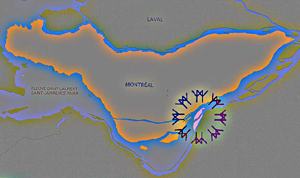 In 1976, I was hired by the City of Montreal to work as a researcher for the Strange, Strange World Pavilion, on St Helen’s Island, which at the time was one of the most popular pavilions still in existence after the famed 1967 World Expo, a groundbreaking design event which defined a new level of esthetics throughout the world and included, readers will recall, the American Biosphere designed by the groundbreaking inventor and genius Buckminster Fuller, and heralded a new age in architectural innovation.
In 1976, I was hired by the City of Montreal to work as a researcher for the Strange, Strange World Pavilion, on St Helen’s Island, which at the time was one of the most popular pavilions still in existence after the famed 1967 World Expo, a groundbreaking design event which defined a new level of esthetics throughout the world and included, readers will recall, the American Biosphere designed by the groundbreaking inventor and genius Buckminster Fuller, and heralded a new age in architectural innovation.
The first map shows the location of the two islands. You will notice the logo of Man and His World, a circle of pairs of figures with two arms raised, indicating the large acreage devoted to this historical event.
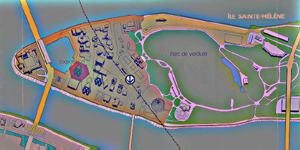 The second map shows where Strange, Strange World was situated on Ile Ste Helene in relation to other buildings. It was next to Swan Lake, at an angle with the 40 foot monumental fire engine red Alexander Calder stabile, a beautiful sculpture which gave a very contemporary look to the site, across from the breathtaking and dizzying 360º Cinema, above the Vanishing Wildlife Pavilion with its rotating cinema, facing the Mexican Pavilion and across from the Humor Pavilion with the Weapons Pavilion below it. An escalator which crept past a large flashing mural of the Nazca lines in Peru led to the entrance to the pavilion where a simple turnstile kept track of the nearly 2 million visitors it recorded over the course of its thirteen years of glorious existence.
The second map shows where Strange, Strange World was situated on Ile Ste Helene in relation to other buildings. It was next to Swan Lake, at an angle with the 40 foot monumental fire engine red Alexander Calder stabile, a beautiful sculpture which gave a very contemporary look to the site, across from the breathtaking and dizzying 360º Cinema, above the Vanishing Wildlife Pavilion with its rotating cinema, facing the Mexican Pavilion and across from the Humor Pavilion with the Weapons Pavilion below it. An escalator which crept past a large flashing mural of the Nazca lines in Peru led to the entrance to the pavilion where a simple turnstile kept track of the nearly 2 million visitors it recorded over the course of its thirteen years of glorious existence.
I was very fortunate to work on this pavilion as it was housed in an extraordinary structure which had served as the Man and the Oceans exhibit at Expo ‘67, and was itself based on hexagonal geodesic principles and made entirely of metal extrusions bolted together and rising to about 100 feet in the air. From the inside, the skeletal hexagonal pattern was entirely visible. Workers would climb very high in the structure, even all the way to the top to repair various things. I confess, I always wanted to climb to the very top myself. It wasn’t that hard to climb, but it was high. So I never went past 50 feet high. It really was amazing to see though... It was such a large open yet closed space where huge exhibits such as a thirty foot tall hot air balloon related to the exploration of the Nazca lines in Peru provided a dramatic visual element as did the Saturn 5 rocket model which measured 65 feet in height and was produced cooperatively by city workers and NASA. Imagine being inside an open honey comb. That’s sort of what it felt and looked like. It was very organic ... and unusual. There were no right angles except from the ground up.
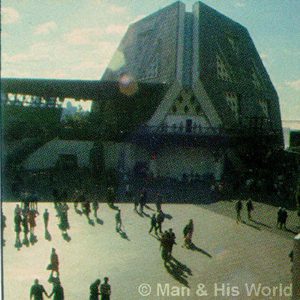 The photos illustrating the pavilion show its unusual shape which announced its even more unusual contents. Unfortunately, these structures were not built to last for many years, in fact the structures stayed up much longer than planned. Today, nothing survives of this marvelous building except for some photographs, its dispersed contents, and fond memories of millions who had the wonderful pleasure of visiting this exhibit and who were awed also by its shape. A movie by Robert Altman, Quintet with Paul Newman and Bibi Andersen was actually filmed inside another similar structure in an advanced state of deterioration on the neighboring Notre Dame Island in the late seventies.
The photos illustrating the pavilion show its unusual shape which announced its even more unusual contents. Unfortunately, these structures were not built to last for many years, in fact the structures stayed up much longer than planned. Today, nothing survives of this marvelous building except for some photographs, its dispersed contents, and fond memories of millions who had the wonderful pleasure of visiting this exhibit and who were awed also by its shape. A movie by Robert Altman, Quintet with Paul Newman and Bibi Andersen was actually filmed inside another similar structure in an advanced state of deterioration on the neighboring Notre Dame Island in the late seventies.
It would seem that another legacy of this site is quite a bit of controversy, speculation, contention, misrepresentation, ignorance, naivete, theorizings, pontifications, mystifications and misconstruences which I hope to put to rest once and for all by letting the world know in extensive detail this chapter of the exhilarating story of Man and His World which already exists in book form with plenty of color photos and a wonderful text elsewhere. By now, a collectible that one occasionally comes across in rare book stores and auctions.
In the deluge of e-mail since this project got under way I have been informed me that a German book has presented a or some photos in a supposedly accurate account of the exhibit (I hope to obtain a copy soon and verify its contents), a French language magazine titled ENIGMA printed my alien on its premier issue in 1995, documentaries such as Strange Universe, The UFO Evidence and possbibly others have also shown it. Incidentally, the issue of photo copyright is somewhat ludicrous in this situation since cameras were completely allowed on the premises, the exhibit had very strong and dramatic green lighting, there was no room to move physically around the case and therefore the camera angles were very limited. So how many photos of the alien does the reader think may be out there with millions of tourists pouring through? Lots!
The original designer of the Strange, Strange World pavilion was Michel Lambert who had apprenticed design from the creators of Expo, being one of the original young designers to actually work on Expo ‘67. He had been the instigator of the exhibit and worked with Carl Sanderson who can best be described as the Charles Fort of this day and age who collected masses of information and evidence concerning unusual phenomena. By 1976, when I appeared on the scene, Sanderson had passed away and it was much harder for the designer to proceed without some serious backup in research. Hundreds and hundreds of phenomena had been presented and new subjects were getting scarce. I came in with an enthusiasm and familiarity with the subject that made him confident that I was just what he needed.
Amusingly, I first turned down the job offer because I didn’t want to be a researcher, I wanted to do the writing. I did not agree with some of the formulations, and I thought they needed tightening. It wasn’t that they were too far out, I believe reality is far greater than we will ever imagine it to be, and being vast and encompassing, many things are possible whether we like it or not. No, it was just that they they lacked precision and could be even stronger sometimes. I have a degree in philosophy and excelled at critical analysis. So I came in looking to correct things! I reluctantly took the position of researcher at the instigation of a co-worker—I was a student on a summer job—and never regretted it since. For Michel, it meant, unbeknownst to me, the careful grooming of an individual to replace himself. He had other dreams where he could do more design work and I fit the peg. My position lasted five years during which I worked on many exciting projects. I learned most of what I know about exhibit design from him and have only fond memories of all of this experience and my co-workers and collaborators.
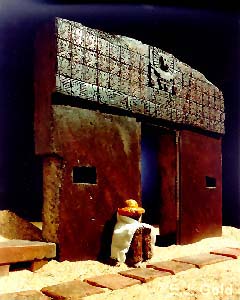 By 1978, I was in charge of the pavilion and Michel was out of the picture as far as content goes. From this point on, I began to clearly define my vision of where this exhibit could go and how it could be improved upon—when it was already fantastic, make no mistake about it. Could such a thing be possible? It had to be. The pavilion needed a constant refreshing of exhibits and they had to be at least as good as what had been there before if not much better. This was a challenge also because the esthetic level was so fabulous. The atmosphere of the exhibit was magical, and like all things magical, it had a scary aspect because it dared to address certain questions and to face the universe open-minded, with a will to understand one’s place as it exists in its broadest reality. Skirting the edges of science, perusing the frontiers of knowledge became a modus operandi of every subject approached. Where lay the limit of knowledge in any explored domain, there lay the focus of my attention. From there it was a matter of penetration towards the unknown and beyond the limits of knowledge. This became the fuel of the exhibits.
By 1978, I was in charge of the pavilion and Michel was out of the picture as far as content goes. From this point on, I began to clearly define my vision of where this exhibit could go and how it could be improved upon—when it was already fantastic, make no mistake about it. Could such a thing be possible? It had to be. The pavilion needed a constant refreshing of exhibits and they had to be at least as good as what had been there before if not much better. This was a challenge also because the esthetic level was so fabulous. The atmosphere of the exhibit was magical, and like all things magical, it had a scary aspect because it dared to address certain questions and to face the universe open-minded, with a will to understand one’s place as it exists in its broadest reality. Skirting the edges of science, perusing the frontiers of knowledge became a modus operandi of every subject approached. Where lay the limit of knowledge in any explored domain, there lay the focus of my attention. From there it was a matter of penetration towards the unknown and beyond the limits of knowledge. This became the fuel of the exhibits.
1978 was an important year for the pavilion because it was its tenth anniversary. The budget was a little more generous, (about $125,000), with the caveat that improvements had to be visible. And they were! The exhibit looked great. In 1978, Strange, Strange World produced a three color calendar-poster announcing its opening from June 22 to September 4 which had the following text on the back:
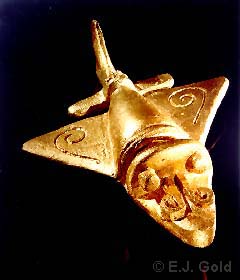 “One of the most popular pavilions has proven to be Strange, Strange World which boasts an average of 250,000 visitors each summer. Strange, Strange World is a thematic pavilion —the only one of its kind in the world— dealing with various enigmatic aspects of the immediate world we live in and of the universe itself.
“One of the most popular pavilions has proven to be Strange, Strange World which boasts an average of 250,000 visitors each summer. Strange, Strange World is a thematic pavilion —the only one of its kind in the world— dealing with various enigmatic aspects of the immediate world we live in and of the universe itself.
“This year, to celebrate its tenth anniversary, Strange, Strange World will renew its presentation of ever-important questions: is there other life in the Universe? Are we being visited by extraterrestrial beings that come from other dimensions? What do they want from us? Why do they not make themselves known? Have we been visited in the past? How can we understand archaeological riddles that do not correspond to our traditional views of ancient civilizations? From where did they get their knowledge?
“True to its tradition, Strange, Strange World will explore a new theme dealing with the most recent scientific discoveries: what is the real nature of man and of the world he lives in? What are these strange streams of energy that flow through his body and into surrounding matter? What is the link between form and energy? Is the Earth a huge magnet attracting energies that flow through the Universe? Can man transmit energy into matter? Are we on the point of explaining what tradition has shown us for centuries? All these questions will find an answer in Strange, Strange World.”
 The second map shows where Strange, Strange World was situated on Ile Ste Helene in relation to other buildings. It was next to Swan Lake, at an angle with the 40 foot monumental fire engine red Alexander Calder stabile, a beautiful sculpture which gave a very contemporary look to the site, across from the breathtaking and dizzying 360º Cinema, above the Vanishing Wildlife Pavilion with its rotating cinema, facing the Mexican Pavilion and across from the Humor Pavilion with the Weapons Pavilion below it. An escalator which crept past a large flashing mural of the Nazca lines in Peru led to the entrance to the pavilion where a simple turnstile kept track of the nearly 2 million visitors it recorded over the course of its thirteen years of glorious existence.
The second map shows where Strange, Strange World was situated on Ile Ste Helene in relation to other buildings. It was next to Swan Lake, at an angle with the 40 foot monumental fire engine red Alexander Calder stabile, a beautiful sculpture which gave a very contemporary look to the site, across from the breathtaking and dizzying 360º Cinema, above the Vanishing Wildlife Pavilion with its rotating cinema, facing the Mexican Pavilion and across from the Humor Pavilion with the Weapons Pavilion below it. An escalator which crept past a large flashing mural of the Nazca lines in Peru led to the entrance to the pavilion where a simple turnstile kept track of the nearly 2 million visitors it recorded over the course of its thirteen years of glorious existence. In 1976, I was hired by the City of Montreal to work as a researcher for the Strange, Strange World Pavilion, on St Helen’s Island, which at the time was one of the most popular pavilions still in existence after the famed 1967 World Expo, a groundbreaking design event which defined a new level of esthetics throughout the world and included, readers will recall, the American Biosphere designed by the groundbreaking inventor and genius Buckminster Fuller, and heralded a new age in architectural innovation.
In 1976, I was hired by the City of Montreal to work as a researcher for the Strange, Strange World Pavilion, on St Helen’s Island, which at the time was one of the most popular pavilions still in existence after the famed 1967 World Expo, a groundbreaking design event which defined a new level of esthetics throughout the world and included, readers will recall, the American Biosphere designed by the groundbreaking inventor and genius Buckminster Fuller, and heralded a new age in architectural innovation. 
 By 1978, I was in charge of the pavilion and Michel was out of the picture as far as content goes. From this point on, I began to clearly define my vision of where this exhibit could go and how it could be improved upon—when it was already fantastic, make no mistake about it. Could such a thing be possible? It had to be. The pavilion needed a constant refreshing of exhibits and they had to be at least as good as what had been there before if not much better. This was a challenge also because the esthetic level was so fabulous. The atmosphere of the exhibit was magical, and like all things magical, it had a scary aspect because it dared to address certain questions and to face the universe open-minded, with a will to understand one’s place as it exists in its broadest reality. Skirting the edges of science, perusing the frontiers of knowledge became a modus operandi of every subject approached. Where lay the limit of knowledge in any explored domain, there lay the focus of my attention. From there it was a matter of penetration towards the unknown and beyond the limits of knowledge. This became the fuel of the exhibits.
By 1978, I was in charge of the pavilion and Michel was out of the picture as far as content goes. From this point on, I began to clearly define my vision of where this exhibit could go and how it could be improved upon—when it was already fantastic, make no mistake about it. Could such a thing be possible? It had to be. The pavilion needed a constant refreshing of exhibits and they had to be at least as good as what had been there before if not much better. This was a challenge also because the esthetic level was so fabulous. The atmosphere of the exhibit was magical, and like all things magical, it had a scary aspect because it dared to address certain questions and to face the universe open-minded, with a will to understand one’s place as it exists in its broadest reality. Skirting the edges of science, perusing the frontiers of knowledge became a modus operandi of every subject approached. Where lay the limit of knowledge in any explored domain, there lay the focus of my attention. From there it was a matter of penetration towards the unknown and beyond the limits of knowledge. This became the fuel of the exhibits.  “One of the most popular pavilions has proven to be Strange, Strange World which boasts an average of 250,000 visitors each summer. Strange, Strange World is a thematic pavilion —the only one of its kind in the world— dealing with various enigmatic aspects of the immediate world we live in and of the universe itself.
“One of the most popular pavilions has proven to be Strange, Strange World which boasts an average of 250,000 visitors each summer. Strange, Strange World is a thematic pavilion —the only one of its kind in the world— dealing with various enigmatic aspects of the immediate world we live in and of the universe itself.